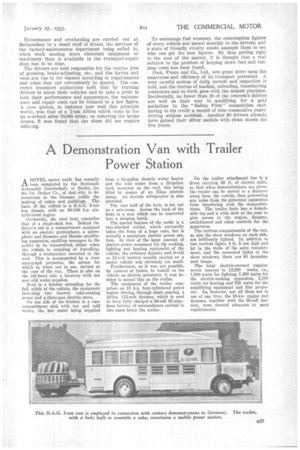A Demonstration Van with Trailer Power Station
Page 49

If you've noticed an error in this article please click here to report it so we can fix it.
ANOVEL motor outfit has recently been completed by the Nationale Automobil Gesellschaft, of Berlin, for the Dr. Oetker Co.' of that city, to demonstrate to the German public the making of cakes and puddings. The basis of the vehicle is a N.A.G. 5-ton bus chassis, with an 80-100 h.p. sixcylin dered engine. Outwardly, the steel body resembles that of a single-deck bus. Behind the driver's cab is a compartment equipped with an electric gramophone, a microphone and Siemens and galske amplifying apparatus, enabling messages to. the public to be transmitted, either when the vehicle is standing or travelling, through a loudspeaker mounted in the roof. This is accompanied by a cinematograph projector, the screen for which is, when not in use, carried at the rear of the van. There is also on the left-hand side a lavatory with hot and cold water supplies.
Next is a kitchen extending for the full width of the vehicle, the equipment including two electric cake-cooking ovens and a three-pan electric stove.
On one side of the kitchen is a twocompartment sink with hot and cold water, the hat water being supplied from a GI-gallon electric water heater and the cold water from a 55-gallon tank mounted on the roof, this being filled by means of an Elmo electric pump. An electric refrigerator is also provided.
The rear half of the body is set out as a sale-room. Across the back of the body is a seat which can be converted into a sleeping berth.
The special feature of the outfit is a two-wheeled trailer, which outwardly takes the form of a huge cake, but is actually a miniature electric power station. In view of the large amount of electric power necessary for the cooking, lighting and heating equipment of the vehicle, the ordinary dynamo and 6-volt or 12-volt battery usually carried on a motor vehicle was obviously too small.
Furthermore, as it was not possible, by reasons of fumes, to install on the vehicle an electric generator, it was decided to mount this on the trailer.
The equipment of the trailer comprises an 18 h.p. four-cylindered petrol engine driving, through chain gearing, a 104w. 115-volt dynamo' which is used to keep fully charged a 60-cell 96-an.hour battery of accumulators carried in two cases below tho trailer.
• On the trailer attachment bar is a drum carrying 65 ft. of electric cable, so that when demonstrations are given, the trailer can be moved to a distance away from the vehicle, thus preventing any noise from the generator apparatus from interfering with the demonstrations. The trailer body has a detachable trip and a wide door at the rear to give access to the engine, dynamo, switchboard and other controls for the apparatus.
The various compartments of the van, as also the show windows on each side, are brilliantly lighted. In addition to two vertical belts, 4 ft. 5 ins, high and let in the walls of the sales compartment, and the concealed lights in the show windows, there are 80 incandescent lamps.
The total electric-current requirements amount to 1Z200 watts, i.e., 1,900-watts for lighting, 7,480 watts for the electric-cooking apparatus, 2,100 watts for heating and 720 watts for the amplifying equipment and Elm projector. As, however, not all these are in use at one time, the 10-kw, engine and dynamo, together with the 60-cell battery, were deemed adequate to meet requirements.




























































































